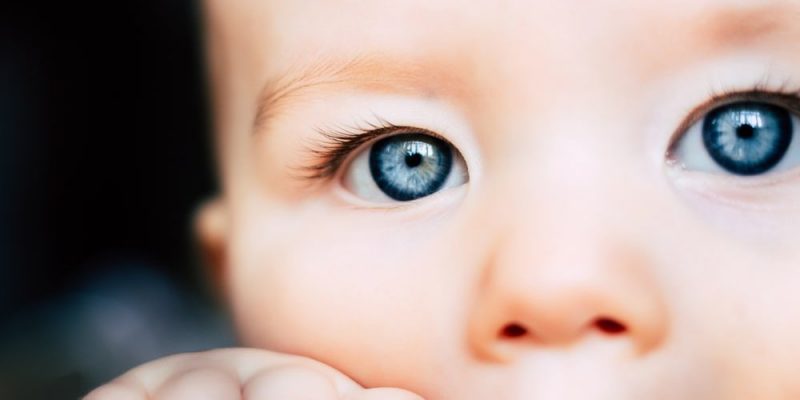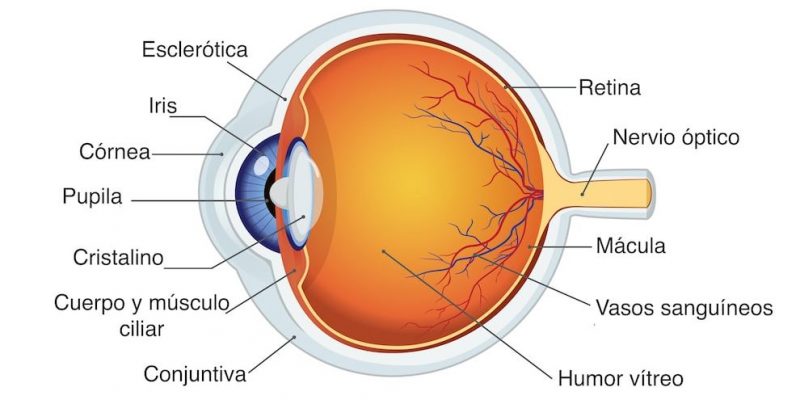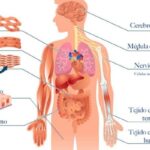We explain what the sense of sight is, what it is for and how it works. Also, the anatomy of the eye and why we see colors.

What is the sense of sight?
We call vision, visual perception or sense of sight one of the five senses through which humans and many animals perceive the surrounding reality. In the case of our species, vision is the most important and the most privileged of the senses, used not only in observing the environment and our interlocutors, but in the act of reading and writing, fundamental in human societies.
Visual perception can be defined as the ability to extract information from the effects of electromagnetic radiation in the objects of the environment. The radiation that is perceived is in the spectrum of the so-called “visible light”, which includes wavelengths between 380 and 780 nanometers. For this reason it is impossible to see in the absence of light.
The information that sight offers is shape, color, position, movement, texture. On the other hand, vision is an active sense, which can be directed and suppressed at will (simply closing the eyelids), unlike other more passive senses, such as smell or hearing, which depends mainly on the functioning of the eyes, but in which different components and internal physiological processes also intervene.
It is a complex process, in which different environmental, bodily and mental factors intervene to produce a more or less objective perception of objects.
What is the sense of sight for?
Vision is a very powerful sense, to the extent that reveals enormous amounts of information about the environment. The dimensions of things and spaces (width, height and depth), colors, movement, texture and other similar experiences of reality are possible thanks to it.
Besides, allow us to predict future events based on their distant perception: a human being on the horizon line can perceive objects up to 5 kilometers away, if weather conditions are favorable.
On the other hand, the view plays a fundamental role in the composition of human society allowing rapid recognition of our interlocutors and also different forms of physical and non-linguistic communication, or more importantly, written communication.
People without a sense of vision have significant difficulties in functioning in society, and they also cannot experience visual aesthetics, that is, they cannot look at a painting, a photograph or a landscape and delight in its poetic or symbolic content. To some extent, the entire human civilization is built on the visual perception of the universe.
How does the sense of sight work?
For visual perception to occur, there must be visible light around, that is, electromagnetic waves of sufficient amplitude to be captured by the human eye. These waves impact the surface of objects and, depending on their nature, they are reflected in one way or another. That reflection is captured by our eyes by penetrating its most superficial transparent layers.
This does not occur in an uncontrolled manner, but rather, as it contracts or expands, The iris and pupil are responsible for modulating the amount of light that enters the eye: in abundant light, the pupil constricts, while if the light is scarce, the pupil opens to let in as much of it as possible. Once this is done, the lens focuses on the perceived object, to project its image onto the backdrop of the retina.
The retina operates like a screen whose sensory cells (rods and cones) are precisely those responsible for transforming light energy into nervous impulses, which travel to the brain through the optic nerve. Once there, you are Nerve signals are interpreted by the geniculate body of the occipital lobe a key process for understanding what is seen.
In fact, the images on the retina are projected inverted, as occurs with the so-called “camera obscuras” (the principle behind the technique of photography), and it is the brain that is in charge of “straightening” them.
Thus, the process of visual perception includes three different processes:
- A physical or optical process entry of light waves into the ocular apparatus.
- a biochemical process in which retinal cells “translate” light into neural electrical information.
- A neurological process in which the brain recognizes and interprets what is perceived in light of the immense amount of information it already has stored.
eye anatomy

The eye is a complex organ, which covers much more than what we perceive with the naked eye, and which can broadly be divided into three differentiated segments: the eyeball, the optic pathways and the annexes of the visual apparatus.
The eyeball. This is the eye itself, that is, a hemispherical structure of around 24 mm in diameter, which is housed in a pair within the orbital cavity of the skull. It is what we perceive when we look another in the eyes. However, the eyeball is structured in three layers and three different chambers, which are:
- The outer layer or sclerocornea. The outermost region of the eye is a layer that covers and protects it, and which in turn includes: the sclera, the “white” part of the eye, composed of fibrous material and covered with a protective mucosa called conjunctiva; and the cornea, the optical “window” of the eye, a transparent portion of the outer membrane that is very poorly vascularized (does not bleed) but has many nerve endings.
- The intermediate layer or uvea. Located below the outer layer, it is the vascular layer of the eye, where most of the blood conduits are, and which in turn includes: the choroid, the posterior region of the eye, which apart from nourishing with oxygenated blood, prevents leakage. of light towards undue regions; the ciliary body, where the liquids that fill the eye are secreted and the ciliary muscle is also controlled, allowing the lens to focus its gaze; and finally the iris, the colored portion of the eye, capable of expanding or contracting depending on the absence or presence of light. Between it and the inner layer is the crystalline lens, the natural lens that allows the eye to focus, adjusting itself depending on the distance or proximity of the objects.
- The inner layer or retina. This is the region of the eye that is sensitive to light and where the images we see are formed. Its anterior area is blind and increases as it approaches the posterior region, where the fovea is located, a small gap where the largest number of visual cells are concentrated (cones and rods, named for their shape, and responsible for vision. central and peripheral respectively) and the point of maximum concentration of vision occurs. In addition, it has a blind area called papilla, where it connects to the optic nerve.
- The anterior chamber. It is the region of the eyeball between the cornea and the iris, filled with aqueous humor, a transparent liquid produced by the ciliary body in order to preserve the internal pressure and shape of the eyeball.
- The rear camera. Located between the iris and the lens, it is where the ciliary processes occur.
- The vitreous chamber. The largest cavity of the eye, located between the lens and the retina, is filled with a transparent gel called vitreous humor. The latter fixes the retina in place and keeps the structure of the eye intact, in addition to preserving its shape against bumps or sudden movements.
The optical pathways. This is the system of transmission of nerve impulses from the retina to the brain, through the optic nerve.
The annexes of the eye. They are the set of muscles, cavities, glands and mucous membranes that surround, support and protect the eyeball. They include the ocular cavity, the eyelids, the lacrimal glands and the lacrimal ducts, as well as the six different muscles of the oculomotor system: the superior oblique muscle, the superior rectus, the medial rectus, the lateral rectus, the rectus inferior and the inferior oblique. The levator muscle of the upper eyelid is added to them, since the lower one is immobile.
Why do we see in colors?
What we commonly call “color” is a certain wavelength that objects reflect that is, the surface of things absorbs most of the electromagnetic spectrum while reflecting another portion, and the latter is the that we can perceive with our eyes.
Similarly, an object that does not absorb any ray of light, but reflects everything, will be white; and on the contrary, one that absorbs the entire spectrum and reflects nothing, will be black. If the light rays do not even hit the object, but pass through it, it will be invisible or transparent.
As for the human eye, it is important to know that our photosensitive cells are capable of perceiving different modes of light: the rods are activated in the dark, for example, and allow us to capture contrasts: whites, blacks and intermediate grays.
Instead, The cones are activated in the presence of light and allow us to perceive colors: a certain type of cone is sensitive to red light, another to blue and another to green, and by combining these three primary colors, our brain recomposes more than 20 million different colors.
Vision care
Vision care focuses on the protection and conservation of the eyes, and to do so it is important to follow the following instructions:
- Do not look directly or intently at the sun under no circumstances, not even to artificial light sources that are comparable in intensity.
- Wear chrome or dark glasses in environments with excess lighting or on days with too much sunlight.
- Do not strain your eyes continuously, subjecting it to reading in the absence of light or exposing it only to the light of screens (cell phones, tablets, computers, etc.).
- Give your eyes breaks during particularly long reading sessions, especially if they are in front of a screen.
- Do not introduce foreign bodies into the eye or possibly irritating or toxic substances, and avoid touching your eyes with dirty hands.
- Go to the ophthalmologist or ophthalmologist regularly, or upon noticing any defect in vision.
Continue with: Sense of hearing
References
- “Visual perception” in Wikipedia.
- “Eye” in Wikipedia.
- “How does vision work?” (video) in Smile and Learn Spanish.
- “The vision” on Ambientech.org.
- “Vision (physiology)” in The Encyclopaedia Britannica.




